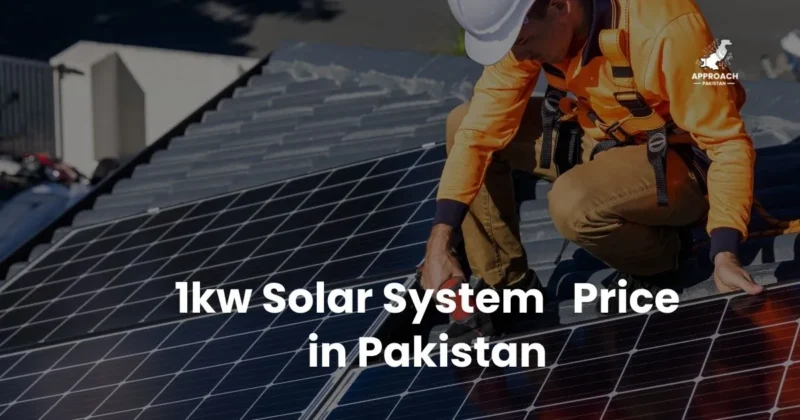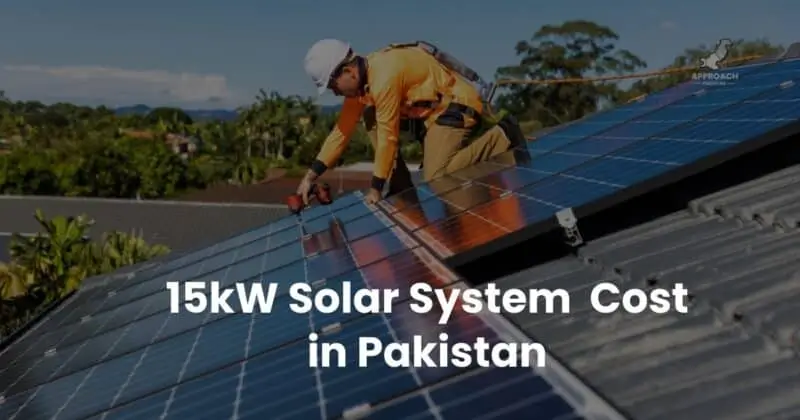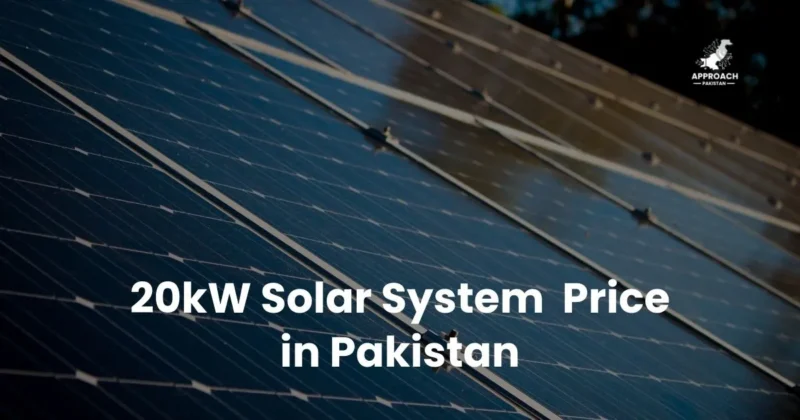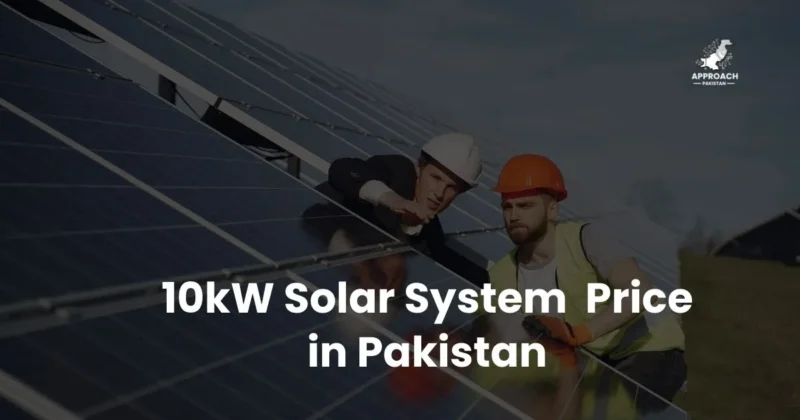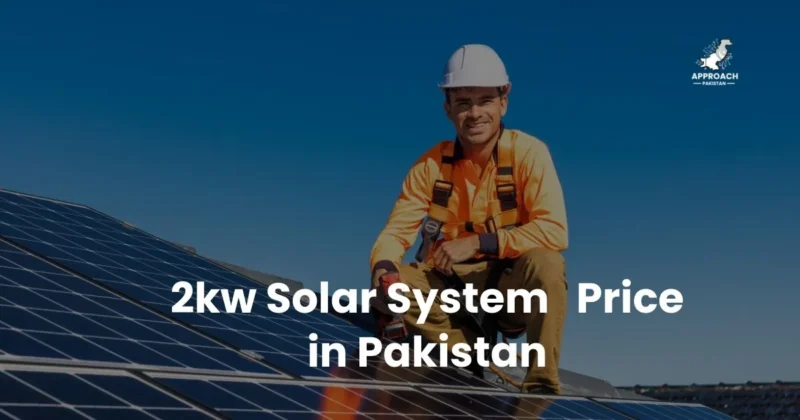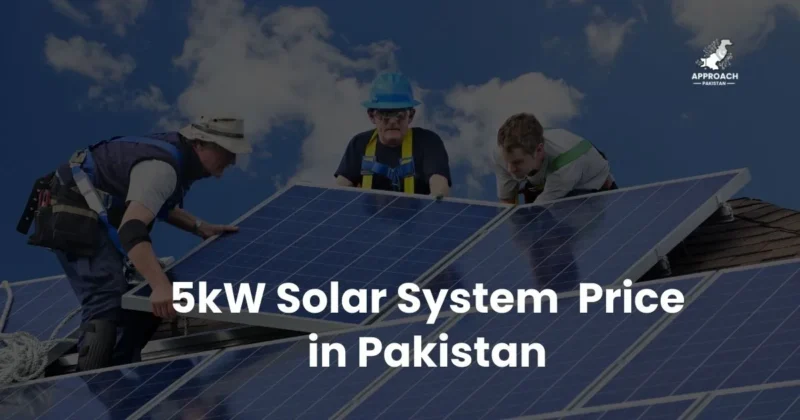6kW Solar System Cost in Pakistan – 2025 Rates & Savings
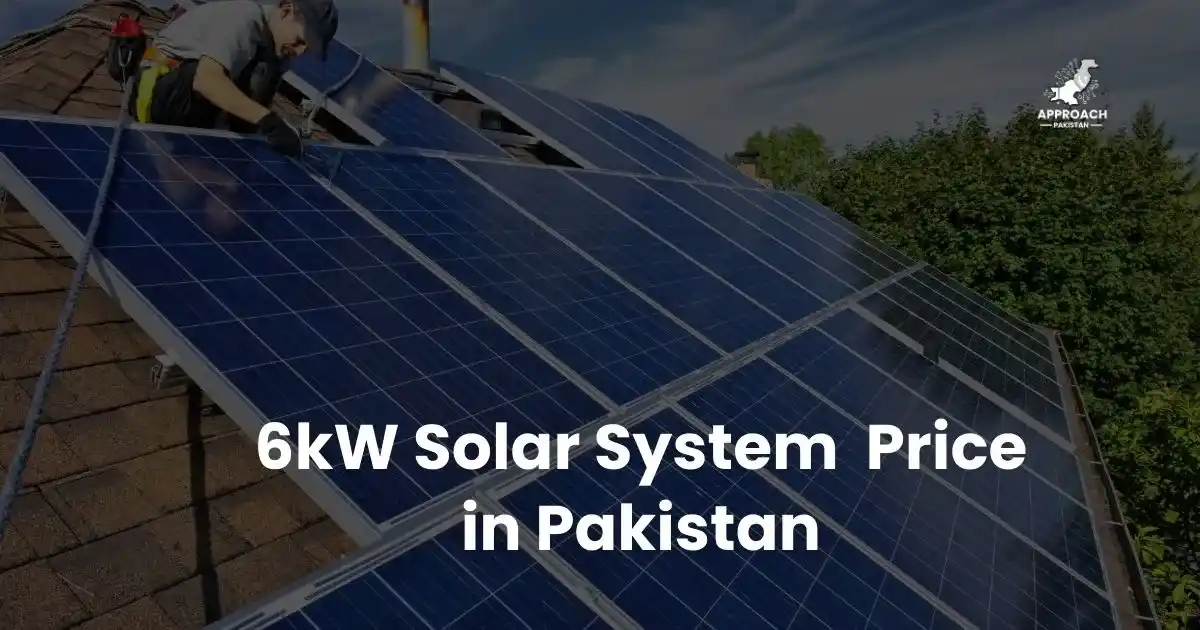
A 6kW solar system in Pakistan costs between PKR 680,000 to PKR 950,000 in June 2025, depending on system type and components. On-grid systems start from PKR 680,000, while hybrid systems with battery backup range from PKR 850,000 to PKR 950,000, offering 70-80% electricity bill reduction.
Your monthly electricity bill crossed PKR 25,000 again last month. Load shedding disrupted your work-from-home schedule three times this week. You’re tired of guessing solar system prices only to discover hidden costs later.
I get it. Pakistani families face the same energy crisis daily. Rising electricity tariffs eat into household budgets while unreliable grid power disrupts modern life.
A 6kW solar system solves both problems. You’ll slash electricity bills by 70-80% while gaining energy independence from Pakistan’s unstable grid.
Introduction & Overview
1.1 What is a 6kW Solar System?
A 6kW solar system generates 6,000 watts of electricity at peak sunlight conditions. It typically includes 10-12 solar panels, one inverter, mounting structure, and electrical components. This system size powers medium to large Pakistani homes with moderate energy consumption.
Think of it as your personal power plant. The system converts sunlight into electricity for immediate use or storage. During sunny days, your 6kW system produces enough power to run air conditioning, refrigerators, lights, and other appliances simultaneously.
Pakistani homes consuming 600-900 units monthly find 6kW systems ideal. The capacity handles daily energy needs while providing room for future appliance additions.
1.2 Why Choose 6kW Solar System in Pakistan?
Pakistan’s abundant sunshine makes 6kW systems highly effective. Lahore receives 5.5 peak sun hours daily, while Karachi gets 6.2 hours. Your system generates 24-30 units of electricity daily in these conditions.
The size perfectly matches typical Pakistani middle-class consumption patterns. Most families use 18-25 units daily, making 6kW systems provide complete energy coverage with surplus for net metering.
Cost-effectiveness drives the popularity. Larger systems like those found in our 8kW solar system price analysis require higher upfront investment without proportional benefits for average homes.
1.3 Government Solar Policies and Incentives 2025
The government offers several incentives making 6kW systems more affordable. Net metering allows selling excess electricity back to the grid at retail rates. You earn credits during sunny months to offset consumption during cloudy periods.
Import duty exemptions on solar equipment reduced component costs by 15-20% in 2025. The State Bank’s renewable energy financing scheme provides loans at 6% annual interest for solar installations.
Provincial governments offer additional benefits. Punjab provides 90% net metering fee waiver for residential systems. To understand how grid-tie systems work in Pakistan and maximize these benefits, proper system selection becomes crucial.
6kW Solar System Pricing & Cost Analysis
2.1 Latest 6kW Solar System Price in Pakistan
6kW on-grid solar systems cost PKR 680,000 to PKR 780,000 in June 2025. Hybrid systems with battery backup range from PKR 850,000 to PKR 950,000. Tier-1 panel brands command 8-12% premium over standard options.
Price variations depend on component quality and installation complexity. Canadian Solar and Longi panels cost PKR 50,000-80,000 more than local alternatives but offer superior warranties and efficiency.
Regional pricing differs across Pakistan. Lahore and Karachi installations cost 5-8% less due to competition and logistics. Smaller cities face 10-15% higher prices due to limited installer availability.
| System Type | Price Range (PKR) | Key Features |
| On-Grid Basic | 680,000 – 720,000 | Local panels, basic inverter |
| On-Grid Premium | 740,000 – 780,000 | Tier-1 panels, advanced monitoring |
| Hybrid Basic | 850,000 – 900,000 | 2-battery backup, standard components |
| Hybrid Premium | 920,000 – 950,000 | Tier-1 panels, lithium batteries |
2.2 Cost Breakdown: Components and Installation
Solar panels consume 60-65% of total system cost. A 6kW system requires 10-12 panels costing PKR 400,000 to PKR 520,000 depending on brand and efficiency ratings.
Inverters account for 15-20% of system cost. Hybrid inverters cost PKR 80,000 to PKR 120,000 more than on-grid versions but provide battery management and backup switching capabilities.
Installation labor ranges from PKR 35,000 to PKR 55,000. Professional installers include mounting structure, AC/DC cabling, earthing system, and safety disconnects in this fee.
2.3 On-Grid vs Hybrid System Price Comparison
On-grid systems cost PKR 170,000 to PKR 200,000 less than hybrid alternatives. You save on battery costs, hybrid inverter premium, and additional safety equipment required for backup systems.
However, hybrid systems provide backup power during outages. For families experiencing frequent load shedding, the extra investment pays off through uninterrupted power supply and reduced generator dependency.
Consider your priorities carefully. If minimizing upfront cost matters most, explore our complete on-grid solar system guide to understand pricing across all system sizes and see how net metering can maximize your savings. For backup power needs, discover complete hybrid solar system benefits and pricing comparisons.
2.4 Financing Options and Payment Plans
Banks offer solar financing at 6-9% annual interest rates. Allied Bank’s solar loan covers up to 85% of system cost with 7-year repayment terms. Monthly installments for a PKR 800,000 system start from PKR 13,500.
Equipment suppliers provide in-house financing options. Many installers offer 12-month installment plans with 15-20% down payment. Some companies accept post-dated cheques for payment flexibility.
Microfinance institutions serve customers without traditional banking relationships. Organizations like Kashf Foundation offer small-scale solar loans with simplified documentation requirements.
2.5 Hidden Costs to Consider
Net metering application fees cost PKR 15,000 to PKR 25,000 depending on your electricity distributor. LESCO charges PKR 18,500 while K-Electric fees reach PKR 23,000 for residential connections.
Annual maintenance contracts cost PKR 8,000 to PKR 12,000 yearly. These include panel cleaning, inverter inspection, and performance monitoring. Skipping maintenance reduces system efficiency by 15-20% annually.
Structural reinforcement may be required for older roofs. Engineers charge PKR 25,000 to PKR 40,000 for roof assessment and strengthening if needed before installation.
Technical Specifications & Components
3.1 Solar Panels: Types, Brands, and Efficiency
6kW systems use 10-12 monocrystalline panels rated 500-590 watts each. Tier-1 brands like Longi, Jinko, and Canadian Solar offer 21-22% efficiency with 25-year performance warranties. Lower-cost alternatives provide 19-20% efficiency at reduced warranty terms.
Monocrystalline panels perform better in Pakistan’s hot climate. They maintain higher efficiency at elevated temperatures compared to polycrystalline alternatives. The 2-3% efficiency advantage translates to 50-100 additional units monthly.
Panel degradation affects long-term performance. Premium brands guarantee 85% output after 25 years while budget options may drop to 80%. This 5% difference means 600-800 units annually over system lifetime.
3.2 Inverter Selection: Hybrid vs On-Grid
On-grid inverters convert DC to AC for immediate consumption or grid export. Brands like Goodwe and Solis offer 97-98% efficiency with integrated monitoring systems. Prices range from PKR 85,000 to PKR 120,000.
Hybrid inverters provide grid-tie and backup functionality in one unit. They manage battery charging, backup switching, and grid synchronization automatically. Premium models include WiFi monitoring and smartphone apps for remote control.
Inverter sizing matters for optimal performance. A 6kW system requires 5-6kW inverter capacity. Oversizing by 10-15% accommodates panel degradation and ensures consistent performance over 15-20 years.
3.3 Battery Options for Hybrid Systems
Tubular batteries remain popular for 6kW hybrid systems. Two 150Ah batteries provide 4-6 hours backup for essential appliances. Total battery cost ranges from PKR 45,000 to PKR 65,000 with 3-5 year replacement cycles.
Lithium batteries offer superior performance but cost 3-4 times more upfront. They provide 80% depth of discharge versus 50% for lead-acid alternatives. Lithium batteries last 8-10 years compared to 3-5 years for tubular options.
Battery sizing depends on backup requirements. Calculate your essential load during outages then multiply by desired backup hours. Most families need 300-500Ah capacity for comfortable evening backup.
3.4 Mounting Structure and Installation Hardware
Aluminum mounting structures cost PKR 25,000 to PKR 35,000 for 6kW systems. Galvanized steel alternatives save PKR 8,000-12,000 but require periodic maintenance in coastal areas due to corrosion.
Roof type affects mounting complexity and cost. Concrete slab roofs use chemical anchors costing PKR 3,000-5,000 extra. Tin roof installations require structural assessment and possible reinforcement.
Quality mounting prevents panel damage during windstorms. Pakistani wind speeds reach 80-100 km/h during monsoons. Proper mounting withstands these conditions when installed according to manufacturer specifications.
3.5 Protective Equipment and Safety Components
AC and DC disconnect switches ensure safe maintenance and emergency shutdowns. These components cost PKR 8,000 to PKR 12,000 but prevent electrical accidents during service work.
Surge protection devices guard against lightning damage common during monsoon season. SPDs cost PKR 5,000 to PKR 8,000 but can save thousands in equipment replacement after electrical storms.
Earthing systems prevent electric shock and equipment damage. Proper earthing requires copper rods, conductors, and connections costing PKR 6,000 to PKR 10,000 for complete installation.storage. These systems are ideal for remote locations but require larger battery banks and careful load management.
Power Generation & Performance
4.1 How Much Electricity Does 6kW System Generate?
A 6kW solar system generates 24-30 units of electricity daily in Pakistani conditions. Annual production ranges from 8,500 to 11,000 units depending on location, weather patterns, and system maintenance. Peak performance occurs during March-May when sunshine and temperatures optimize output.
Daily generation varies seasonally. Summer months produce 28-32 units daily while winter output drops to 18-22 units. Monsoon season sees significant variation with cloudy days generating only 8-12 units.
System orientation affects performance substantially. South-facing panels at 30-degree tilt generate maximum electricity. East-west orientations reduce output by 15-20% but may better match consumption patterns.
4.2 Daily, Monthly, and Annual Energy Production
Morning generation starts around 7 AM reaching peak output between 11 AM and 2 PM. Your 6kW system produces maximum 6,000 watts during these peak hours when sun intensity exceeds 1,000 watts per square meter.
Monthly production follows predictable patterns. March through May generate 950-1,100 units monthly. December through February produce 550-750 units. Monsoon months vary widely from 600-900 units depending on cloud cover.
Annual production determines financial returns. Well-maintained systems in Lahore generate 9,200-9,800 units yearly. Karachi systems produce 9,800-10,500 units while northern areas like Islamabad generate 8,500-9,200 units annually.
4.3 Factors Affecting Solar System Performance
Temperature impacts affect panel efficiency significantly. Panels lose 0.4% efficiency per degree above 25°C. Pakistani summer temperatures reach 45°C reducing panel output by 8-10% during hottest months.
Dust accumulation reduces generation by 15-25% without regular cleaning. Lahore’s air quality requires monthly panel washing while coastal areas need bi-weekly cleaning due to salt deposits.
Shading devastates system performance. Even partial shading on one panel can reduce entire string output by 30-50%. Tree shadows, neighboring buildings, and antenna installations require careful consideration during planning.
4.4 Seasonal Variations in Pakistan
Summer months provide maximum generation despite heat penalties. Extended daylight hours and intense sunshine compensate for temperature losses. June-August systems generate 85-95% of rated capacity.
Winter offers moderate temperatures but shorter days. December-January systems operate at optimal efficiency but produce 60-70% of summer output due to reduced sunlight hours and lower sun angles.
Monsoon season creates unpredictable performance. July-September generation varies daily from 20-80% depending on cloud cover. Systems require monitoring to adjust consumption patterns during extended cloudy periods.
6kW Solar System Appliance Compatibility & Load Management
5.1 Complete List of Appliances 6kW Can Power
A 6kW system simultaneously powers 1.5-ton air conditioner, refrigerator, LED lights, fans, TV, washing machine, and small kitchen appliances. Total connected load can reach 4,500-5,500 watts during peak usage with proper load management strategies.
Air conditioning consumes the largest portion. A 1.5-ton inverter AC draws 1,200-1,800 watts depending on outdoor temperature and efficiency rating. Older non-inverter units consume 2,200-2,800 watts making load balancing crucial.
Kitchen appliances require careful scheduling. Microwave ovens (1,200W), electric kettles (1,500W), and toasters (800W) should run individually to prevent overloading during peak cooking hours.
| Appliance Category | Power Range (Watts) | Simultaneous Units |
| 1.5 Ton AC | 1,200-1,800 | 1-2 units |
| Refrigerator | 150-300 | Multiple units |
| LED Lights | 9-15 each | 50+ units |
| Ceiling Fans | 70-120 each | 8-12 units |
| Washing Machine | 500-800 | 1 unit |
5.2 Air Conditioning Requirements and Options
Inverter air conditioners work best with solar systems. They adjust power consumption based on cooling requirements and available solar generation. DC inverter models consume 40-50% less electricity than conventional units.
Multiple AC units require careful planning. Two 1-ton inverter ACs consume less power than one 2-ton unit while providing zonal cooling control. This flexibility maximizes solar utilization and comfort.
Smart AC controllers optimize solar consumption. These devices monitor solar generation and adjust AC settings automatically. Units start cooling when excess solar power becomes available and reduce consumption during cloud cover.
5.3 Load Balancing for Maximum Efficiency
Morning loads should prioritize water heating and washing machines when solar generation starts building. These time-shiftable loads maximize solar utilization before peak afternoon consumption.
Afternoon peak hours suit high-power appliances. Air conditioning, cooking equipment, and ironing work best between 11 AM and 3 PM when 6kW systems generate maximum output.
Evening loads require battery backup or grid support. As solar generation declines after 4 PM, prioritize essential appliances and defer non-critical consumption until next day’s solar production.
5.4 Peak vs Off-Peak Usage Strategies
Peak solar hours offer free electricity for any appliance. Schedule washing machines, dishwashers, and water pumps between 10 AM and 4 PM to maximize solar utilization and minimize grid consumption.
Off-peak appliances should focus on essentials. Evening hours require careful load management with lighting, fans, and entertainment systems taking priority over energy-intensive equipment.
Time-of-use optimization reduces electricity bills significantly. Shifting 60-70% of daily consumption to solar hours eliminates peak tariff charges while maximizing net metering credits.
Financial Benefits & ROI Analysis
6.1 Monthly Electricity Bill Savings
A 6kW solar system reduces monthly electricity bills by PKR 15,000 to PKR 22,000 for average Pakistani households. Families consuming 800-1,000 units monthly see 70-85% bill reduction depending on consumption patterns and net metering utilization.
Actual savings depend on tariff structure and consumption timing. Families using electricity during solar hours achieve maximum savings by directly consuming generated power instead of purchasing from the grid.
Net metering amplifies savings through excess power sales. Surplus generation during sunny months creates credits offsetting consumption during cloudy periods or high-usage months.
6.2 Payback Period Calculation
Simple payback occurs within 3.5 to 4.5 years for most 6kW installations. Systems costing PKR 750,000 with PKR 18,000 monthly savings achieve payback in 42 months excluding financing costs.
Interest rates affect payback significantly. Self-financed systems recover investment faster than financed alternatives. A 7% loan extends payback to 5-6 years but monthly savings still exceed loan payments.
Electricity tariff increases accelerate payback. NEPRA raises tariffs 8-12% annually making solar savings grow over time. Earlier installations benefit more from these increases compared to delayed decisions.
6.3 25-Year Investment Returns
Long-term returns exceed traditional investments significantly. A PKR 750,000 6kW system generates PKR 4.5-5.5 million in electricity savings over 25 years at current tariff escalation rates.
Net present value calculations show attractive returns. Using 8% discount rate, 6kW systems provide 18-22% internal rate of return over their operational lifetime including maintenance costs.
System degradation affects long-term returns moderately. Premium panels maintaining 85% output after 25 years generate PKR 400,000-600,000 more than budget alternatives over system lifetime.
6.4 Net Metering Revenue Potential
Excess generation creates significant revenue streams. Well-designed 6kW systems export 200-400 units monthly during peak production periods generating PKR 5,000-10,000 in monthly credits.
Seasonal variations affect net metering income. Summer months typically generate surplus while winter consumption may exceed production. Annual net metering usually favors solar system owners with 10-15% surplus generation.
Banking mechanisms protect against fluctuations. To learn more about net metering benefits and requirements, accumulated credits from high-production months offset consumption during low-generation periods ensuring year-round bill reduction.
6.5 Tax Benefits and Government Incentives
Import duty exemptions reduce system costs by 12-15%. Solar panels, inverters, and batteries enter Pakistan duty-free under renewable energy policies making installations more affordable.
Accelerated depreciation benefits commercial installations. Businesses can depreciate solar systems at 90% in the first year providing immediate tax savings for revenue-generating establishments.
Provincial incentives vary across regions. Punjab offers expedited approvals and reduced connection fees while Sindh provides technical support and financing assistance through designated banks.gs can exceed PKR 6-8 million.
Installation Guide & Requirements
7.1 Pre-Installation Site Assessment
Professional site assessment costs PKR 3,000-5,000 but prevents costly installation problems. Engineers evaluate roof condition, electrical infrastructure, shading analysis, and structural capacity before system design finalization.
Roof assessment determines mounting feasibility. Concrete roofs require core drilling for chemical anchors while tin roofs need structural evaluation for wind and weight loads.
Electrical evaluation ensures safe integration. Existing wiring, main panel capacity, and earthing systems require inspection and possible upgrades for code compliance.
Shading analysis optimizes panel placement. Professional tools identify seasonal shading patterns helping maximize system output through strategic panel positioning.
7.2 Roof Space Requirements (504 sq ft)
A 6kW system requires 450-550 square feet of unshaded roof space. Panel dimensions vary by brand but typical installations need 20×25 feet rectangular area with proper spacing for maintenance access.
Roof orientation affects space requirements. South-facing installations achieve maximum density while east-west orientations may require additional panels to compensate for efficiency losses.
Ventilation spacing prevents overheating. Panels need 2-3 inches clearance from roof surface and 6-inch gaps between rows for air circulation maintaining optimal operating temperatures.
7.3 Professional Installation Process
Installation typically requires 2-3 days for complete system commissioning. Day one involves mounting structure installation and panel placement. Day two covers electrical connections and inverter setup.
Quality control ensures long-term performance. Professional installers follow manufacturer guidelines for torque specifications, cable routing, and weatherproofing preventing premature failures.
Testing and commissioning verify system operation. Installers measure panel voltages, inverter performance, and grid synchronization ensuring safe operation before energizing the system.
7.4 Post-Installation Testing and Commissioning
Performance testing validates system output. Installers measure actual generation against predicted values ensuring panels and inverters operate within specifications.
Safety inspections confirm code compliance. Electrical connections, earthing systems, and disconnect switches undergo thorough testing before final approval and energization.
Documentation handover includes warranties, operation manuals, and monitoring system access. Proper documentation ensures warranty coverage and helps with future maintenance requirements.
7.5 Net Metering Application Process
Application submission requires technical drawings, equipment specifications, and safety certificates. Most distribution companies process residential applications within 30-45 days after document submission.
Meter installation follows application approval. Distribution companies install bidirectional meters enabling credit accumulation for excess power export to the grid.
Grid synchronization testing ensures safe operation. Technical teams verify protection systems and synchronization equipment before authorizing commercial operation and credit generation.
6kW System Comparison & Alternatives
8.1 6kW vs 5kW Solar System Comparison
6kW systems cost PKR 120,000-150,000 more than 5kW alternatives but generate 1,800-2,200 additional units annually. The extra capacity handles larger homes and provides room for future appliance additions making the upgrade cost-effective for growing families.
Daily generation differences matter significantly. 5kW systems produce 20-25 units daily while 6kW systems generate 24-30 units. The 4-5 unit difference translates to PKR 1,200-1,500 monthly savings at current tariff rates.
Investment efficiency favors 6kW systems for medium-large homes. Cost per watt drops with larger systems making 6kW installations more economical than multiple smaller systems.
For detailed analysis of smaller systems, see our complete 5kW solar system price breakdown showing when smaller capacity makes sense for budget-conscious installations.
8.2 6kW vs 8kW Solar System Analysis
8kW systems suit large homes with multiple air conditioners or significant daytime consumption. They cost PKR 200,000-250,000 more than 6kW alternatives but handle 1,200-1,500 unit monthly consumption.
Roof space requirements increase substantially. 8kW systems need 650-750 square feet of unshaded area compared to 450-550 feet for 6kW installations.
Net metering benefits grow with larger systems. 8kW installations typically export more excess power during peak production periods creating higher credit accumulation.
To explore larger capacity options, check our detailed 8kW solar system price analysis showing when bigger systems provide better value for high-consumption households.
8.3 Brand Comparison: Jinko vs Longi vs JA Solar
Tier-1 panel brands offer 21-22% efficiency with 25-year warranties commanding 10-15% price premiums. Longi leads efficiency ratings at 22.3% while Jinko provides best value for performance. JA Solar offers competitive pricing with proven reliability in Pakistani conditions.
Longi panels excel in hot climate performance. Their advanced cell technology maintains higher efficiency at elevated temperatures common during Pakistani summers.
Jinko offers comprehensive warranties with local service support. Their 25-year linear warranty and 12-year product warranty provide security for long-term investment protection.
JA Solar balances cost and performance effectively. Their panels provide reliable operation at competitive pricing making them popular for price-sensitive installations.
8.4 When to Choose Higher Capacity Systems
Multiple air conditioners require larger systems. Homes running 2+ tons of cooling simultaneously need 8kW or larger capacity for comfortable operation during peak summer months.
Future expansion plans justify oversizing. Families planning electric vehicle charging, swimming pool equipment, or home office additions benefit from excess capacity installation.Commercial applications always benefit from larger systems. Businesses maximize roof utilization and achieve better economies of scale with 10kW+ installations compared to residential-sized systems.mance.

